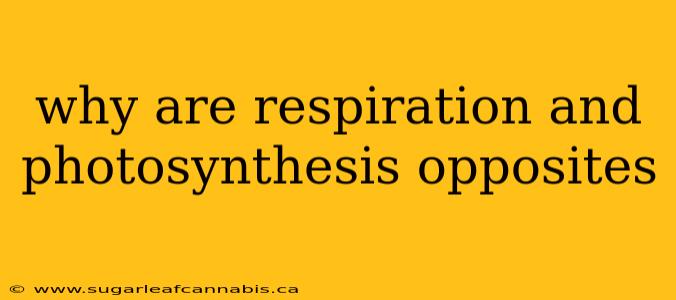Photosynthesis and respiration are fundamental processes in biology, often described as opposites. Understanding why requires examining their inputs, outputs, and the overall energy flow. This article delves into the specifics, exploring the intricacies of these vital processes.
The Core Differences: Inputs and Outputs
The simplest way to understand why photosynthesis and respiration are considered opposites is to compare their inputs and outputs.
Photosynthesis: Capturing Sunlight's Energy
Photosynthesis is the process plants and some other organisms use to convert light energy into chemical energy in the form of glucose (a sugar). The inputs for this process are:
- Carbon dioxide (CO2): Absorbed from the atmosphere.
- Water (H2O): Absorbed from the soil through the roots.
- Sunlight: Provides the energy to drive the reaction.
The outputs of photosynthesis are:
- Glucose (C6H12O6): A sugar molecule that stores the captured energy. This is the plant's food source.
- Oxygen (O2): Released as a byproduct into the atmosphere.
Respiration: Releasing Stored Energy
Cellular respiration, on the other hand, is the process by which organisms break down glucose to release the stored energy for their life processes. The inputs are:
- Glucose (C6H12O6): The energy-rich sugar molecule.
- Oxygen (O2): Needed as an electron acceptor in the process.
The outputs of cellular respiration are:
- Carbon dioxide (CO2): Released as a byproduct.
- Water (H2O): A byproduct of the energy-releasing reactions.
- ATP (Adenosine Triphosphate): The energy currency of the cell, used to power various cellular activities. Heat is also released.
The Opposites in Action: A Balanced Ecosystem
Notice the remarkable symmetry? The products of photosynthesis (glucose and oxygen) are the reactants of respiration. Conversely, the products of respiration (carbon dioxide and water) are the reactants of photosynthesis. This cyclical relationship demonstrates their opposing but interconnected nature. It's a beautifully balanced system that sustains life on Earth.
Plants, through photosynthesis, convert light energy into chemical energy stored in glucose. Animals and plants then use cellular respiration to break down that glucose, releasing the stored energy to power their functions. This constant exchange of gases and energy creates a vital cycle for all living organisms.
Beyond the Basics: A Deeper Dive into the Processes
The seemingly simple equations mask complex biochemical pathways. Photosynthesis involves two main stages: the light-dependent reactions and the light-independent reactions (Calvin cycle). Respiration also involves a series of complex steps, including glycolysis, the Krebs cycle, and the electron transport chain.
While both processes involve numerous enzymes and intricate mechanisms, the overall direction of energy flow and the exchange of key molecules reveal their opposing nature. Photosynthesis stores energy, while respiration releases it.
Photosynthesis Equation:
6CO₂ + 6H₂O + Light Energy → C₆H₁₂O₆ + 6O₂
Cellular Respiration Equation:
C₆H₁₂O₆ + 6O₂ → 6CO₂ + 6H₂O + ATP (and Heat)
Frequently Asked Questions (FAQs)
Q: Is respiration only in animals?
A: No. All living organisms, including plants, carry out cellular respiration to release energy from glucose. Plants photosynthesize and respire.
Q: What happens if photosynthesis stops?
A: If photosynthesis were to cease, oxygen production would stop, severely impacting the atmosphere. The food chain would collapse as plants, the base of most food chains, would die.
Q: Can respiration occur without oxygen?
A: Yes, a process called anaerobic respiration can occur in the absence of oxygen. It's less efficient than aerobic respiration, however, producing less ATP.
Conclusion
In conclusion, photosynthesis and respiration are truly opposing processes. One captures energy from sunlight and stores it in glucose, while the other releases that stored energy for use by living organisms. Understanding their intricate relationship is crucial to comprehending the fundamental workings of life on Earth. The cyclical exchange of gases and energy highlights the interconnectedness of all living things within an ecosystem.
